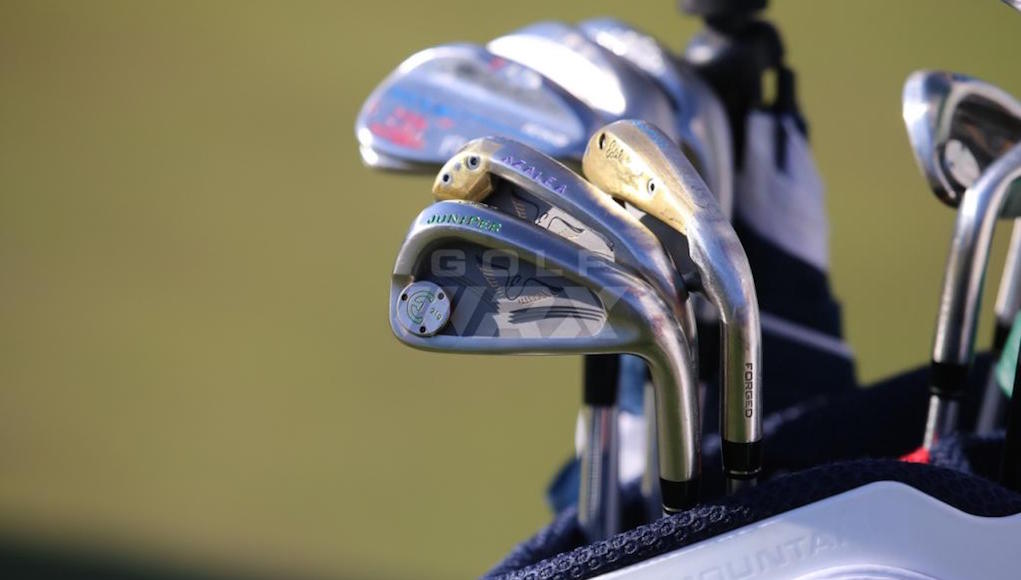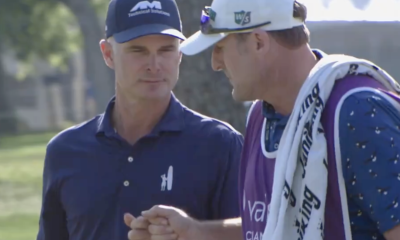Opinion & Analysis
What I learned from my single-length irons experiment

Among the stories for this year’s Masters, the serious club folks show a serious interest in Bryson DeChambeau, specifically his single-length clubs. This evokes memories for me, as I experimented with a single-length set many years ago.
First a little history. Back in the mid ’80s, a golf pro by the name of Jimmy Shack from Royal Oak Country Club in Titusville, Florida, came up with a concept for a single-length set. He managed to get the Tommy Armour Company interested, and they came out with the EQL irons in 1989. They were a single-length set using the 6-iron length as standard. Despite a strong marketing push, they were relatively short lived and eventually disappeared into the great club box in the sky.
Fast forward to the mid ’90s when I was designing sets for Adams Golf and the idea of single length re-appeared, at least for my personal clubs. I read that Bryson is 6 feet 1 inches tall, and I strongly suspect his height was a factor in his single-length set. Before arthritis and age took their toll, I was 6 foot 3 inches tall, and was facing a personal club-fitting problem. It’s funny, but I clearly remembered my mindset at the time.
“Where was it written that a set of irons had to be based on a 37.5-inch 5 iron? Why couldn’t the 5 iron be 40 inches or 34 inches? Why did the increments have to be 0.5 inches?” I figured it all started with a Scotsman, who was probably 5-foot 9-inches or so, shaping a set of clubs that fit him. As decades passed, it became “standard.”
As I saw it, the objective with a set of irons/wedges was to have a club that went a maximum distance, working back to a club that went the shortest distance. The key factor was an equal gap from one club to another. Given this rather broad premise, I turned to the club-fitting system I had designed to see what evolved.
One of the keys in our club-fitting system was establishing a comfortable position at address. We measured knuckles to the ground standing erect (more consistent than fingertips because of hand size). We combined this with what we called maximum drop — how much the hands lowered gripping the club — the idea being a solid address position before we got into flex, lie, etc.
One thing I learned is all of us are not ideally suited to a proper address position in conjunction with clubs we could play. For example, I am long from the waist up, which means to get a comfortable address position I needed clubs 3 inches over standard length, and they were simply too long. For a guy 6 foot 8 inches to 6 foot 10 inches, no problem, but for me, problem. I used to tell people that not everyone has a body that can handle the required length, so in some cases you have to bend over at address a little extra. Given that I couldn’t automatically fit myself, I started with the maximum distance and gapping and worked backward. It wasn’t about the clubs; it was about ball flight.
I remembered the equal-length story and started to experiment. I liked the length of short irons when I made them all like 6 irons, but 5 iron and down were too short. One thing that I’m taking as a given here is the readers understand the need for different head weights and lie angles. Add 3 inches to a standard PW and it becomes significantly “head heavy.” The playing lie changes, too, and all of those things have to be recognized. As I experimented, my emphasis was also on trying to make a set with constant inertia. I wanted the clubs to all swing the same so I would be more consistent controlling ball flight, even when hitting different kinds of shots.
After much work, I ended up with a “tri” single-length set, which I labeled The Oxymoron’s. My longer irons (4-6) were all one length, my 7-8 irons slightly shorter and the higher-lofted clubs were a little more than 2 inches over standard. I felt comfortable at address, so any gapping issues were attacked with loft. Every club had unusual head weights, and they were all were back-weighted — again, my approach to obtaining constant swing inertia. I didn’t have a 3 iron, because another experiment resulted in a rather odd-looking long iron patterned after the Troon clubs of the 1800s.
How did the irons work out? They were pretty good; I think I would have really liked them with a bit more fine tuning. I’ll never know. We got pretty busy, and I essentially stopped playing for the better part of 10 years, so my inertial irons idea disappeared. We did introduce irons as a company, but they were industry standard specs. We didn’t influence the market; it influenced us. Besides, my clubs were for me and I’m not standard.
I’m not convinced there isn’t a way to improve a set of irons, so at 77 I’m still messing around. Do I think there is a place in the industry for single length sets? I’d say in the general market, no. Possibly in some custom fitting applications where the size of the player is outside normal standards.
In the business, there are things that are nice and play well, but aren’t technically different. And there are ideas that when fully tested identify a technical improvement to making clubs. It’s the latter that keeps us experimenting.
- LIKE606
- LEGIT106
- WOW19
- LOL19
- IDHT9
- FLOP22
- OB14
- SHANK59
19th Hole
Vincenzi’s 2024 Texas Children’s Houston Open betting preview

As the Florida swing comes to an end, the PGA Tour makes its way to Houston to play the Texas Children’s Houston Open at Memorial Park Golf Course.
This will be the fourth year that Memorial Park Golf Course will serve as the tournament host. The event did not take place in 2023, but the course hosted the event in 2020, 2021 and 2022.
Memorial Park is a par-70 layout measuring 7,432 yards and features Bermudagrass greens. Historically, the main defense for the course has been thick rough along the fairways and tightly mown runoff areas around the greens. Memorial Park has a unique setup that features three Par 5’s and five Par 3’s.
The field will consist of 132 players, with the top 65 and ties making the cut. There are some big names making the trip to Houston, including Scottie Scheffler, Wyndham Clark, Tony Finau, Will Zalatoris and Sahith Theegala.
Past Winners at Memorial Park
- 2022: Tony Finau (-16)
- 2021: Jason Kokrak (-10)
- 2020: Carlos Ortiz (-13)
In this article and going forward, I’ll be using the Rabbit Hole by Betsperts Golf data engine to develop my custom model. If you want to build your own model or check out all of the detailed stats, you can sign up using promo code: MATTVIN for 25% off any subscription package (yearly is best value).
Key Stats For Memorial Park
Let’s take a look at several metrics for Memorial Park to determine which golfers boast top marks in each category over their last 24 rounds:
Strokes Gained: Approach
Memorial Park is a pretty tough golf course. Golfers are penalized for missing greens and face some difficult up and downs to save par. Approach will be key.
Total Strokes Gained: Approach per round in past 24 rounds:
- Tom Hoge (+1.30)
- Scottie Scheffler (+1.26)
- Keith Mitchell (+0.97)
- Tony Finau (+0.92)
- Jake Knapp (+0.84)
Strokes Gained: Off the Tee
Memorial Park is a long golf course with rough that can be penal. Therefore, a combination of distance and accuracy is the best metric.
Total Strokes Gained: Off the Tee per round in past 24 rounds:
- Scottie Scheffler (+0.94)
- Kevin Dougherty (+0.93)
- Cameron Champ (+0.86)
- Rafael Campos (+0.84)
- Si Woo Kim (+0.70)
Strokes Gained Putting: Bermudagrass + Fast
The Bermudagrass greens played fairly fast the past few years in Houston. Jason Kokrak gained 8.7 strokes putting on his way to victory in 2021 and Tony Finau gained in 7.8 in 2022.
Total Strokes Gained Putting (Bermudagrass) per round past 24 rounds (min. 8 rounds):
- Adam Svensson (+1.27)
- Harry Hall (+1.01)
- Martin Trainer (+0.94)
- Taylor Montgomery (+0.88)
- S.H. Kim (+0.86)
Strokes Gained: Around the Green
With firm and undulating putting surfaces, holding the green on approach shots may prove to be a challenge. Memorial Park has many tightly mowed runoff areas, so golfers will have challenging up-and-down’s around the greens. Carlos Ortiz gained 5.7 strokes around the green on the way to victory in 2020.
Total Strokes Gained: Around the Green per round in past 24 rounds:
- Mackenzie Hughes (+0.76)
- S.H. Kim (+0.68)
- Scottie Scheffler (+0.64)
- Jorge Campillo (+0.62)
- Jason Day (+0.60)
Strokes Gained: Long and Difficult
Memorial Park is a long and difficult golf course. This statistic will incorporate players who’ve had success on these types of tracks in the past.
Total Strokes Gained: Long and Difficult in past 24 rounds:
- Scottie Scheffler (+2.45)
- Ben Griffin (+1.75)
- Will Zalatoris (+1.73)
- Ben Taylor (+1.53)
- Tony Finau (+1.42)
Course History
Here are the players who have performed the most consistently at Memorial Park.
Strokes Gained Total at Memorial Park past 12 rounds:
- Tyson Alexander (+3.65)
- Ben Taylor (+3.40)
- Tony Finau (+2.37)
- Joel Dahmen (+2.25)
- Patton Kizzire (+2.16)
Statistical Model
Below, I’ve reported overall model rankings using a combination of the five key statistical categories previously discussed.
These rankings are comprised of SG: App (24%) SG: OTT (24%); SG: Putting Bermudagrass/Fast (13%); SG: Long and Difficult (13%); SG: ARG (13%) and Course History (13%)
- Scottie Scheffler
- Wyndham Clark
- Tony Finau
- Joel Dahmen
- Stephan Jaeger
- Aaron Rai
- Sahith Theegala
- Keith Mitchell
- Jhonnatan Vegas
- Jason Day
- Kurt Kitayama
- Alex Noren
- Will Zalatoris
- Si Woo Kim
- Adam Long
2024 Texas Children’s Houston Open Picks
Will Zalatoris +2000 (Caesars)
Scottie Scheffler will undoubtedly be difficult to beat this week, so I’m starting my card with someone who I believe has the talent to beat him if he doesn’t have his best stuff.
Will Zalatoris missed the cut at the PLAYERS, but still managed to gain strokes on approach while doing so. In an unpredictable event with extreme variance, I don’t believe it would be wise to discount Zalatoris based on that performance. Prior to The PLAYERS, the 27-year-old finished T13, T2 and T4 in his previous three starts.
Zalatoris plays his best golf on long and difficult golf courses. In his past 24 rounds, he ranks 3rd in the category, but the eye test also tells a similar story. He’s contended at major championships and elevated events in the best of fields with tough scoring conditions. The Texas resident should be a perfect fit at Memorial Park Golf Club.
Alex Noren +4500 (FanDuel)
Alex Noren has been quietly playing some of his best golf of the last half decade this season. The 41-year-old is coming off back-to-back top-20 finishes in Florida including a T9 at The PLAYERS in his most recent start.
In his past 24 rounds, Noren ranks 21st in the field in Strokes Gained: Off the Tee, 30th in Strokes Gained: Around the Green, 25th in Strokes Gained: Total on long and difficult courses and 21st in Strokes Gained: Putting on fast Bermudagrass greens.
In addition to his strong recent play, the Swede also has played well at Memorial Park. In 2022, Noren finished T4 at the event, gaining 2.2 strokes off the tee and 7.0 strokes on approach for the week. In his two starts at the course, he’s gained an average of .6 strokes per round on the field, indicating he is comfortable on these greens.
Noren has been due for a win for what feels like an eternity, but Memorial Park may be the course that suits him well enough for him to finally get his elusive first PGA Tour victory.
Mackenzie Hughes +8000 (FanDuel)
Mackenzie Hughes found himself deep into contention at last week’s Valspar Championship before faltering late and finishing in a tie for 3rd place. While he would have loved to win the event, it’s hard to see the performance as anything other than an overwhelming positive sign for the Canadian.
Hughes has played great golf at Memorial Park in the past. He finished T7 in 2020, T29 in 2021 and T16 in 2022. The course fit seems to be quite strong for Hughes. He’s added distance off the tee in the past year or and ranks 8th in the field for apex height, which will be a key factor when hitting into Memorial Park’s elevated greens with steep run-off areas.
In his past 24 rounds, Hughes is the best player in the field in Strokes Gained: Around the Greens. The ability to scramble at this course will be extremely important. I believe Hughes can build off of his strong finish last week and contend once again to cement himself as a President’s Cup consideration.
Akshay Bhatia +8000 (FanDuel)
Akshay Bhatia played well last week at the Valspar and seemed to be in total control of his golf ball. He finished in a tie for 17th and shot an impressive -3 on a difficult Sunday. After struggling Thursday, Akshay shot 68-70-68 in his next three rounds.
Thus far, Bhatia has played better at easier courses, but his success at Copperhead may be due to his game maturing. The 22-year-old has enormous potential and the raw talent to be one of the best players in the world when he figures it all out.
Bhatia is a high upside play with superstar qualities and may just take the leap forward to the next stage of his career in the coming months.
Cameron Champ +12000 (FanDuel)
Cameron Champ is a player I often target in the outright betting market due to his “boom-or-bust” nature. It’s hard to think of a player in recent history with three PGA Tour wins who’s been as inconsistent as Champ has over the course of his career.
Despite the erratic play, Cam Champ simply knows how to win. He’s won in 2018, 2019 and 2021, so I feel he’s due for a win at some point this season. The former Texas A&M product should be comfortable in Texas and last week he showed us that his game is in a pretty decent spot.
Over his past 24 rounds, Champ ranks 3rd in Strokes Gained: Off the Tee and 30th in Strokes Gained: Total on long and difficult courses. Given his ability to spike at any given time, Memorial Park is a good golf course to target Champ on at triple digit odds.
Robert MacIntyre +12000 (FanDuel)
The challenge this week is finding players who can possibly beat Scottie Scheffler while also not dumping an enormous amount of money into an event that has a player at the top that looks extremely dangerous. Enter McIntyre, who’s another boom-or-bust type player who has the ceiling to compete with anyone when his game is clicking on all cylinders.
In his past 24 rounds, MacIntyre ranks 16th in the field in Strokes Gained: Off the Tee, 17th in Strokes Gained: Around the Green and 10th in Strokes Gained: Total on long and difficult courses.
MacIntyre’s PGA Tour season has gotten off to a slow start, but he finished T6 in Mexico, which is a course where players will hit driver on the majority of their tee shots, which is what we will see at Memorial Park. Texas can also get quite windy, which should suit MacIntyre. Last July, the Scot went toe to toe with Rory McIlroy at the Scottish Open before a narrow defeat. It would take a similar heroic effort to compete with Scheffler this year in Houston.
Ryan Moore +15000 (FanDuel)
Ryan Moore’s iron play has been absolutely unconscious over his past few starts. At The PLAYERS Championship in a loaded field, he gained 6.1 strokes on approach and last week at Copperhead, he gained 9.0 strokes on approach.
It’s been a rough handful of years on Tour for the 41-year-old, but he is still a five-time winner on the PGA Tour who’s young enough for a career resurgence. Moore has chronic deterioration in a costovertebral joint that connects the rib to the spine, but has been getting more consistent of late, which is hopefully a sign that he is getting healthy.
Veterans have been contending in 2024 and I believe taking a flier on a proven Tour play who’s shown signs of life is a wise move at Memorial Park.
- LIKE7
- LEGIT1
- WOW0
- LOL0
- IDHT0
- FLOP0
- OB0
- SHANK1
Opinion & Analysis
Ryan: Why the race to get better at golf might be doing more harm than good

B.F. Skinner was one of the most important psychologists of the 20th century, developing the foundation of the development of reinforcement, and in doing so, creating the concept of behaviorism. In simple terms, this means that we are conditioned by our habits. In practical terms, it explains the divide between the few and far between elite instructors and college coaches.
To understand the application, let’s quickly review one of B.F. Skinner’s most important experiments; superstitions in the formation of behavior by pigeons. In this experiment, food was dispensed to pigeons at random intervals. Soon, according to Skinner, the pigeons began to associate whatever action they were doing at the time of the food being dispensed. According to Skinner, this conditioned that response and soon, they simply haphazardly repeated the action, failing to distinguish between cause and correlation (and in the meantime, looking really funny!).
Now, this is simply the best way to describe the actions of most every women’s college golf coach and too many instructors in America. They see something work, get positive feedback and then become conditioned to give the feedback, more and more, regardless of if it works (this is also why tips from your buddies never work!).
Go to a college event, particularly a women’s one, and you will see coaches running all over the place. Like the pigeons in the experiment, they have been conditioned into a codependent relationship with their players in which they believe their words and actions, can transform a round of golf. It is simply hilarious while being equally perturbing
In junior golf, it’s everywhere. Junior golf academies make a living selling parents that a hysterical coach and over-coaching are essential ingredients in your child’s success.
Let’s be clear, no one of any intellect has any real interest in golf — because it’s not that interesting. The people left, including most coaches and instructors, carve out a small fiefdom, usually on the corner of the range, where they use the illusion of competency to pray on people. In simple terms, they baffle people with the bullshit of pseudo-science that they can make you better, after just one more lesson.
The reality is that life is an impromptu game. The world of golf, business, and school have a message that the goal is being right. This, of course, is bad advice, being right in your own mind is easy, trying to push your ideas on others is hard. As a result, it is not surprising that the divorce rate among golf professionals and their instructors is 100 percent. The transfer rate among college players continues to soar, and too many courses have a guy peddling nefarious science to good people. In fact, we do at my course!
The question is, what impact does all this have on college-age and younger kids? At this point, we honestly don’t know. However, I am going to go out on a limb and say it isn’t good.
Soren Kierkegaard once quipped “I saw it for what it is, and I laughed.” The actions of most coaches and instructors in America are laughable. The problem is that I am not laughing because they are doing damage to kids, as well as driving good people away from this game.
The fact is that golfers don’t need more tips, secrets, or lessons. They need to be presented with a better understanding of the key elements of golf. With this understanding, they can then start to frame which information makes sense and what doesn’t. This will emancipate them and allow them to take charge of their own development.
- LIKE13
- LEGIT4
- WOW1
- LOL2
- IDHT0
- FLOP1
- OB0
- SHANK11
19th Hole
Vincenzi’s 2024 Valspar Championship betting preview: Elite ballstrikers to thrive at Copperhead

The PGA TOUR will stay in Florida this week for the 2024 Valspar Championship.
The Copperhead Course at Innisbrook Resort is a par 71 measuring 7,340 yards and features Bermudagrass greens overseeded with POA. Infamous for its difficulty, the track will be a tough test for golfers as trouble lurks all over the place. Holes 16, 17 and 18 — also known as the “Snake Pit” — make up one of the toughest three-hole stretches in golf and should lead to a captivating finish on Sunday.
The field is comprised of 156 golfers teeing it up. The field this week is solid and is a major improvement over last year’s field that felt the impact of players skipping due to a handful of “signature events” in a short span of time.
Past Winners at Valspar Championship
- 2023: Taylor Moore (-10)
- 2022: Sam Burns (-17)
- 2021: Sam Burns (-17)
- 2019: Paul Casey (-8)
- 2018: Paul Casey (-10)
- 2017: Adam Hadwin (-14)
- 2016: Charl Schwartzel (-7)
- 2015: Jordan Spieth (-10)
In this article and going forward, I’ll be using the Rabbit Hole by Betsperts Golf data engine to develop my custom model. If you want to build your own model or check out all of the detailed stats, you can sign up using promo code: MATTVIN for 25% off any subscription package (yearly is best value).
Key Stats For Copperhead
1. Strokes Gained: Approach
Strokes Gained: Approach grades out as the most important statistic once again this week. Copperhead really can’t be overpowered and is a second-shot golf course.
Total SG: Approach Over Past 24 Rounds (per round)
- Tony Finau (+.90)
- Nick Taylor (+.81)
- Justin Thomas (+.77)
- Greyson Sigg (+.69)
- Christiaan Bezuidenhout (+.67)
2. Good Drive %
The long hitters can be a bit limited here due to the tree-lined fairways and penal rough. Playing from the fairways will be important, but laying back too far will cause some difficult approaches with firm greens that may not hold shots from long irons.
Golfers who have a good balance of distance and accuracy have the best chance this week.
Good Drive % Over Past 24 Rounds
- Brice Garnett (+91.3%)
- Zach Johnson (+91.1%)
- Sam Ryder (+90.5%)
- Ryan Moore (+90.4%)
- Aaron Rai (+89.7%)
3. Strokes Gained: Ball Striking
Adding ball-striking puts even more of a premium on tee-to-green prowess in the statistical model this week. Golfers who rank highly in ball-striking are in total control of the golf ball which is exceedingly important at Copperhead.
SG: Ball Striking Over Past 24 Rounds:
- Xander Schauffele (+1.32)
- Keith Mitchell (+1.29)
- Tony Finau (+1.24)
- Cameron Young (+1.17)
- Doug Ghim (+.95)
4. Bogey Avoidance
With the conditions likely to be difficult, avoiding bogeys will be crucial this week. In a challenging event like the Valspar, oftentimes the golfer who is best at avoiding mistakes ends up on top.
Gritty golfers who can grind out difficult pars have a much better chance in an event like this than a low-scoring birdie-fest.
Bogey Avoidance Over Past 24 Rounds
- Brice Garnett (+9.0)
- Xander Schauffele (+9.3)
- Austin Cook (+9.7)
- Chesson Hadley (+10.0)
- Greyson Sigg (+10.2)
5. Strokes Gained: Total in Difficult Conditions
Conditions will be tough this week at Copperhead. I am looking for golfers who can rise to the occasion if the course plays as difficult as it has in the past.
Strokes Gained: Total in Difficult Conditions Over Past 24 rounds
- Xander Schauffele (+1,71)
- Min Woo Lee (+1.39)
- Cameron Young (+1.27)
- Jordan Spieth (+1.08)
- Justin Suh (+.94)
6. Course History
That statistic will tell us which players have played well at Copperhead in the past.
Course History Over Past 24 rounds
- Patrick Cantlay (+3.75)
- Sam Burns (+2.49)
- Davis Riley (+2.33)
- Matt NeSmith (+2.22)
- Jordan Spieth (+2.04)
The Valspar Championship Model Rankings
Below, I’ve compiled overall model rankings using a combination of the five key statistical categories previously discussed — SG: Approach (27%), Good Drive % (15%), SG: BS (20%), Bogeys Avoided (13%), Course History (13%) Strokes Gained: Total in Difficult Conditions (12%).
- Xander Schauffele
- Doug Ghim
- Victor Perez
- Greyson Sigg
- Ryan Moore
- Tony Finau
- Justin Thomas
- Sam Ryder
- Sam Burns
- Lucas Glover
2024 Valspar Championship Picks
Justin Thomas +1400 (DraftKings)
Justin Thomas will be disappointed with his finish at last week’s PLAYERS Championship, as the past champion missed the cut despite being in some decent form heading into the event. Despite the missed cut, JT hit the ball really well. In his two rounds, the two-time major champion led the field in Strokes Gained: Approach per round.
Thomas has been up and down this season. He’s missed the cut in two “signature events” but also has finishes of T12 at the Arnold Palmer Invitational, T12 at the Waste Management Phoenix Open, T6 at the Pebble Beach AT&T Pro-Am and T3 at the American Express. In his past 24 rounds, he ranks 3rd in the field in Strokes Gained: Approach and 6th in Strokes Gained: Ball Striking in the field.
Thomas loves Copperhead. In his last three tries at the course, he’s finished T13, T3 and T10. Thomas would have loved to get a win at a big event early in the season, but avoidable mistakes and a balky putter have cost him dearly. I believe a trip to a course he loves in a field he should be able to capitalize on is the right recipe for JT to right the ship.
Christiaan Bezuidenhout +6000 (FanDuel)
Christiaan Bezuidenhout is playing spectacular golf in the 2024 season. He finished 2nd at the American Express, T20 at Pebble Beach and T24 at the Genesis Invitational before finishing T13 at last week’s PLAYERS Championship.
In his past 24 rounds, the South African ranks 3rd in the field in Strokes Gained: Approach and 26th in Strokes Gained: Ball Striking. Bezuidenhout managed to work his way around TPC Sawgrass last week with minimal damage. He only made five bogeys in the entire week, which is a great sign heading into a difficult Copperhead this week.
Bezuidenhout is winless in his PGA Tour career, but certainly has the talent to win on Tour. His recent iron play tells me that this week could be a breakthrough for the 35-year-old who has eyes on the President’s Cup.
Doug Ghim +8000 (FanDuel)
Doug Ghim has finished in the top-16 of his past five starts. Most recently, Ghim finished T16 at The PLAYERS Championship in a loaded field.
In his past 24 rounds, Ghim ranks 8th in Strokes Gained: Approach and 5th in Strokes Gained: Ball Striking. In terms of his fit for Copperhead, the 27-year-old ranks 12th in Bogey Avoidance and 7th in Strokes Gained: Total in Difficult Conditions, making him a great fit for the course.
Ghim has yet to win on Tour, but at one point he was the top ranked Amateur golfer in the world and played in the 2017 Arnold Palmer Cup and 2017 Walker Cup. He then won the Ben Hogan award for the best male college golfer in 2018. He certainly has the talent, and there are signals aplenty that his talent in ready to take him to the winner’s circle on the PGA Tour.
Sepp Straka +8000 (BetRivers)
Sepp Straka is a player who’s shown he has the type of game that can translate to a difficult Florida golf course. The former Presidents Cup participant won the 2022 Honda Classic in tough conditions and should thrive with a similar test at Copperhead.
It’s been a slow 2024 for Straka, but his performance last week at the PLAYERS Championship surely provides some optimism. He gained 5.4 strokes on approach as well as 1.88 strokes off the tee. The tee-to-green game Straka showed on a course with plenty of danger demonstrates that he can stay in control of his golf ball this week.
It’s possible that the strong performance last week was an outlier, but I’m willing to bet on a proven winner in a weaker field at a great number.
Victor Perez +12000 (FanDuel)
Victor Perez is no stranger to success in professional golf. The Frenchman has three DP World Tour wins including a Rolex Series event. He won the 2019 Alfred Dunhill Links Championship, as well as the 2023 Abu Dhabi HSBC Championship, which are some big events.
Perez earned his PGA Tour card this season and enters the week playing some fantastic golf. He finished in a tie for 16th in Florida at the Cognizant Classic and then tied for third in his most recent start at the Puerto Rico Open.
In his past 24 rounds in the field, Perez ranks 11th in Strokes Gained: Approach, 1oth in Strokes Gained: Ball Striking, 6th in Good Drive % and 15th in Bogey Avoidance.
Perez comes in as a perfect fit for Copperhead and offers serious value at triple-digit odds.
- LIKE16
- LEGIT3
- WOW2
- LOL1
- IDHT0
- FLOP1
- OB2
- SHANK6
-

 19th Hole1 day ago
19th Hole1 day agoJohn Daly stuns fans into silence with brutal opening tee shot on PGA Tour Champions
-

 19th Hole3 weeks ago
19th Hole3 weeks agoPaulina Gretzky opens up on receiving death threats following DJ’s move to LIV Golf
-

 19th Hole5 days ago
19th Hole5 days ago2-time major champ announces shock retirement from the sport at age of 33
-

 19th Hole6 days ago
19th Hole6 days agoEdoardo Molinari reveals the latest PGA Tour golfer to turn down ‘good offer’ from LIV Golf
-

 19th Hole1 week ago
19th Hole1 week agoScottie Scheffler had an interesting response when asked how he ‘quiets the noise’ following Players victory
-

 19th Hole1 week ago
19th Hole1 week agoJon Rahm dealt fresh blow to hopes of qualifying for 2025 Ryder Cup
-

 Equipment2 weeks ago
Equipment2 weeks agoBest driver 2024: The best driver for you, as recommend by expert club fitters
-

 19th Hole4 days ago
19th Hole4 days agoWhy Kevin Streelman sought USGA approval to use this equipment tool as he leads Valspar after round one





















SteveK
Oct 7, 2017 at 2:27 am
I just can’t seem to hit my irons pure and I blame it on the different shaft lengths. It’s so obvious that a single shaft length is the logical way to go. Why in God’s name do golf clubs need to be various lengths? Doesn’t that mean I must have 13 different swing planes?!!
Mat
Jul 1, 2017 at 7:12 pm
It’s funny. Everyone bags either SLI or 1/2″ steps. The truth is that if you built a set at 1/4″ steps, you’d really get the best of both… SLI would fly more “normally” and land better, and the physical change would assist almost the same as true SLI. Imagine only 1″ between a 5-9 iron instead of 2″…
Craig Waggaman
Feb 15, 2017 at 5:33 pm
I have been fascinated by the possibilities of single length irons ever since I started dabbling in club making many years ago. So i did something I have never done- pre-ordered a set of Cobra F7 One single length irons. I received them about a week ago and will be writing about my experiences on my golf blog:
linkswanderer.com
Feel free to take a look and ask questions or comment.
Scientific Golfer
Jan 7, 2017 at 8:23 pm
Ironic and pathetic …. the average golfer (95% of all golfers) keep seeking a golf solution that doesn’t involve physical conditioning, sport-specific training and then performance training. They just seek an equipment solution that avoids time commitment to the sport… and then delude themselves into buying a game with the ‘best’ equipment no matter the cost.
What we are witnessing now is the squeezing of the last $$$$ from a declining delusional golf population and will desperately spend to rescue their fantasies. Look at the OEM advertising… it’s so obvious.
Most recreational golfers and other sports don’t devote enough time to practice and refuse to admit they themselves are the fault of their incompetence. “If I could just adjust the clubs to my personal swing!” …. so the OEMs are producing multi-adjustable clubs for failures who have more money than brains!!! Sorry for the rant, and discouraging comments from others who have been hit with this reality.
Andre
Nov 17, 2016 at 7:27 am
Very interesting article Mister Adams,
You mentionned backweighting and constant moment of inertia. Just curious as to how you went about that and if you reached your target MOI. Did you try to obtain a certain swingweight across the set or else?
Thank you
Andre
Nov 17, 2016 at 7:20 am
Very interesting article Mister Adams.
Ryan morris
Oct 24, 2016 at 5:19 am
I purchased a set of slc last week. Had the best round of my life and i play about 2 to 3 rds per week. I felt the real magic came in hitting the 3-5 iron (its was almost boringly easy). On the range and course, im showing zero distance loss. Its amazing the misconceptions out there, even the pro at the course said, im sure you wont…..well i bet if…..etc etc
Regardless, they work. Getting people to try them will be the challenge. I did notice a little control issue with my pw, at first, but i think the range has sorted this out the last few days.
OB
Sep 7, 2017 at 3:33 pm
Incredible, fantastic, wonderful, almost too good to be true …. which it is not!
Ted
Oct 6, 2016 at 2:36 am
I own a set of EQLs: 2-7 are 7i length; 8-PW are 8i length. Easy as pie to hit; distances are predictable. 2 iron is dead straight unless I mess up the swing. Warm ups? Only need to hit 2 irons to warm up. Only drawback (for you chumsp who want a reason to reject the concept) is that the PW @ 8i length could be more accurate at shorter yardages, i.e., below it’s standard PW shot @ 8i length. Fix: choke down, put the ball back in the stance, and knockdowns are dead on. I also own PING BECUs, Cal BB Golds, and set of custom Alpha blades worth more than all these sets combined. Have owned just about every set/concept out there. Am now making a longer set of single length irons with some Matrix graphite X shafts because the concept works. Will go with 4i & 5i lengths to make the transition from these to the driver & woods more consistent through the round, and because I love to choke down & hit knockdowns. To each his own. If God wanted golf to be consistent, we probably would all be left-handers… (no offense, Phil)…
Brian
Jun 12, 2016 at 11:59 am
wishon Sterlings have resolved all of these issues and now we have the best option for single length on the market. Hundreds of sets have been sold and every client I have built for is thrilled with the results. Look up a competent club fitter from Tom Wishon’s site and you can try them.
Justin
May 27, 2016 at 7:06 pm
Before we start: I know… I’m always late for the party. Not just “fashionably late”- freaking late.
Anyway, I see Single-Length irons as being on par with ideas like True Length. It’s not a fad, but it’s not going to threaten the status quo, either. Someone, somewhere, will benefit from these so-called quirky ideas. If it helps someone enjoy their time on the course more, I’m all for it.
Jack Wullkotte
May 6, 2016 at 4:08 pm
I’m not an engineer, mathematician, scientist, or scholar of any kind, just a klutzy old clubmaker, but, I can assure you that the market for a set of irons, all the same length is going to be minimal at best. Naturally, there’s always someone out there who will buy anything that’s new, because they have more money than brains. Way back in the 1950’s, while working for the MacGregor Golf Co., we made a set of irons for someone in which all the irons were the same length. He returned within a few months and requested that we make them all standard length. I believe the length was 37″ and I think the swing weight was D-6. In order to make the 3 iron 38 1/2 inches, we would have had to grind about 3/4 of an ounce of weight off of the head, 1/2 an ounce off the 4 iron and a quarter ounce off the 5 iron. The 6 iron head would have remained the same. We would have then had to add 1/4 ounce of weight to the 7 iron, 1/2 ounce to the 8 iron, 3/4 ounce to the 9 iron and 1 ounce to the pitching wedge in order to get a standard D-6 swingweight throughout the set. Our plant manager, Bob Lysaght told the guy to go suck and egg or buy a new set. True story.
Jonathan Birch
Apr 29, 2016 at 11:10 pm
I’ve been playing the single-length irons from 1 Iron Golf for about 12 years and would never go back to traditional length clubs again. Once you get used to using the same swing and ball position with every iron magic happens. I’m not impressed with the other companies who have sprung up over the past couple of years offering single-length irons since it is painfully obvious that they are just climbing onto the band wagon and really have little, if any, experience in this area.
300 Yard Pro
May 31, 2016 at 1:47 am
1 Iron are the biggest junk clubs. That’s their problem.
Christopher Fotos
Jun 11, 2016 at 8:57 pm
I, too, have been playing 1 Iron Golf clubs for something like a decade now. High quality — I’ve never had to replace the irons or woods during that time. I’ve gotta say I marvel a bit about the recent appearance of stories about single-length clubs without mentioning the continued success of 1 Iron Golf, which arrived at this destination quite some time ago.
I don’t have it handy, but company founder David Lake has a booklet about the history of clubmaking as it relates to length. My recollection is imperfect but IIRC back in the wood-shaft days many clubs were single length. There are also anecdotes thrown out there occasionally about pros using custom-fit single length irons without talking about it. I remember one such tale claiming a set of clubs used by Nicklaus back in the days, now on display in Columbus, show many of the irons are single-length (they’re sitting in a bag).
duke
Apr 27, 2016 at 6:31 pm
looking for set of old tommy armour EQLl irons! same length. Im 6’6″bad worn out back so before spending a fortune on custom made, thinkin this might be starting point.
Justin
May 27, 2016 at 6:58 pm
What do you consider a fortune? Value Golf has their Pinhawk SL set that starts out at $234. Throw in a GW, SW and LW and it bumps it up to $351. In that configuration, it comes with the Apollo Standard Stepless irons (personally, I really like these) and the Karma Black Velvet (similar to Golf Pride Tour Velvet) grips. You can have the shafts and/or grips swapped out, for an upcharge.
As of right now they’re out of stock, though a couple of sites are saying they’ll be available in June.
KevS.
Apr 18, 2016 at 5:13 pm
Barney, you say playing lie angles must adjust through the set of a single-length irons…and yet on the TV broadcast for the RBC at Harbor Town, Nick Faldo said he’s discussed the set with DeChambeau several times and his set features a consistent lie angle for all irons regardless of loft. I believe Faldo mentioned all irons are 77 degrees (13 degrees upright), but don’t quote me on the specific numbers because I did not make a note of it. Frankly, I don’t understand how he plays tough trouble shots at times, and Gary McCord was also mentioning the specifics of sand bunker shots with a sand wedge the length of a 6-iron.
Deano
Apr 13, 2016 at 4:53 pm
To all the Shank, Flop, and OB critics – what gives? This was a good article from a legend club maker. What’s Pebble Beach – LOL?
Shallowface
Apr 12, 2016 at 8:12 pm
The Armour EQL was available from 1989-1994. I have all of those catalogs. I wouldn’t call that short lived.
Not saying they sold very well as it’s been a long time since I saw a full set, especially when compared with the 845s which I find on a regular basis everywhere from Ebay to thrift stores.
Ron
Apr 12, 2016 at 12:22 pm
Barney and others….
I tried the single length experiment a few years ago by taking a set of heads with an undercut
sole and adding weight in the cavity for the 5 and 6 irons, and played with the 8,9,W a little too
heavy. I have a loft and lie machine, so adjusting the lie angles to match was no problem. The
set played OK, but I didn’t like the wedge being so long, so I didn’t give it a good enough chance before going back to my trusty Ping i5’s.
When I bought my next new set (Callaway Xr’s last spring), I adjusted the length of them to
have only a 1/4 inch differential from one club to another. This means that the difference between
the 6 iron and the wedge is only 1 inch. This way, I feel I have the best of both worlds with the set
being “almost single length”, yet maintaining weight increments. It works for me, and I guess in the final analysis, I guess that’s all that matters!
MRC
Apr 9, 2016 at 10:06 pm
Enjoyed your article Mr.Adams.
Appreciate the nuggets and most of all, the fact that you’ve been there and done that!!
Keep up the great writing.
oldredtop
Apr 9, 2016 at 8:09 am
To those who would like some technical background on single length clubs, may I suggest a trip to GolfWRX contributor Tom Wishon’s website. http://wishongolf.com/designs/sets/sterling-irons-single-length-set/
His company has just released a single length iron set and and there is a great deal of technical information there along with the philosophy behind his approach to single length. Are they for everyone? Certainly not. But for me, if Tom is willing to put his name on a set of single length irons, the concept is solid and worth a little study.
oldredtop
Apr 9, 2016 at 9:39 am
disclaimer: I am not financially affiliated with Wishon Golf Technology in any form or fashion. Just a happy customer. 🙂 (771CSI irons)
Bif
Apr 10, 2016 at 2:05 am
That’s affiliation enough!
Barney Adams
Apr 8, 2016 at 11:32 pm
Re Moe’s clubs. I made a set of irons he played with for several years. They were not single length. They were however very head heavy offset somewhat by oversize and heavier grips.
Bif
Apr 10, 2016 at 2:04 am
It’s what happens when you have small hands like yours Smizzle and can’t handle man-sized grips
Ike16
Apr 8, 2016 at 5:32 pm
Have played twice with my SL irons. All heads weighed 270 grams, shafts are Steel Fibre i70 tipped light R and all weighted the same at 37 inches, FLO tested, and finished with Winn W-5 grips. Every club is within 17 MOI points. Each has exactly the same lie. The feel of the swing with each is identical. Have to sometimes look twice at the number on the toe to make sure which one is used. The biggest challenge to date is getting used to wedges that are on the ground farther from my toes. That’s look, not feel. Next is forcing myself to play each in a coordinated (same) position. No more forward or back due to loft or length. These are cast heads and I have played forged for ages, but as a builder the challenge was too great to ignore. So far the playing distances are building trust and the plan is to keep these in the bag for the foreseeable future.
toad37
Nov 7, 2016 at 2:15 pm
Would love an update… how are they working for you?
Joshuaplaysgolf
Apr 8, 2016 at 4:10 pm
My buddy is playing with single-length irons. Actually just finally got his pinhawk heads in today. It’s been really interesting talking with him about the challenges he is running into and the process of getting things dialed in, as he made his old irons all single-length just to see if he liked it. What I’ve noticed more than anything, is he hits his mid-short irons MILES into the air. We live in Denver, so t’s relatively windy, and when even a slight (5-10mph) breeze picks up, he has to pay extra attention to conditions. This will probably get ironed out when he gets the new lofts dialed in, just my observation so far…but interesting concept. Especially for those of us with nagging backs.
Loser
May 18, 2016 at 11:05 pm
You cant just chop down a regular set and make them the same length.
kn
Apr 8, 2016 at 2:47 pm
Hi Barney,
I enjoy reading your articles. I think DeChambeau has a hard row to hoe, especially if he wants to make golf his profession. He’ll have to win in a way nobody else has done it, and in today’s environment of cutting-edge golf equipment. He’ll always be playing with the wind in his face, so to speak. Until he wins, and it’s probably going to have to be a lot, he’ll just be considered a quirky egghead on the peripheral. That may be a tad brutal, but it’s also reality. If we all played with single-length clubs, maybe the story would be different.
Mike
Apr 8, 2016 at 7:26 pm
I couldn’t disagree with this more.
Grim
Apr 8, 2016 at 8:47 pm
Even if he won a couple, it still wouldn’t be enough, he would have win 40 or 50 events
Buddy
Apr 8, 2016 at 10:57 pm
Until he wins? U.S. Am doesn’t count?
Buddy's an eejit
Apr 9, 2016 at 12:48 am
Have you looked at who’ve won the US Am in the past? Tells you everything about your question
Guy
Apr 9, 2016 at 9:30 pm
Sure there’s some past winners who didn’t do much on tour. But the stat meant was “until he wins” which he has. As someone who can’t even win a club championship, I feel some respect should be payed to winning the U.S. Am.
Cyd2293
Apr 10, 2016 at 9:52 am
+1
Seve
Apr 16, 2016 at 11:01 am
I totally agree. I would love a US Am on my resume!
Scott
Apr 29, 2016 at 4:37 pm
Yeah like that Tiger guy and that Jack guy and that Arnold guy. Those guys did nothing.
300 Yard Pro
May 20, 2016 at 12:34 pm
He won the top two Am events the same year. Only people to do that were some losers called Jack and Tiger. I wonder what happened to those losers?
Loser
May 18, 2016 at 11:07 pm
He contended at the Masters, pounding tons of the best in the world and backed it up with a T4 at Harbor.
Alex
Apr 8, 2016 at 1:05 pm
Great read Barney. My question is, while I have been fitted for clubs before I feel that at 5’6″ (on a good day) I should try to have my irons cut down more than the standard 0.5″ for us little guys. So, if I were to go closer to 1-1.5″ off would I need to add weight to the club heads? Would this really be beneficial? Because, I love my putter at 32″ and I’m fairly upright putter.
Thanks
Barney Adams
Apr 8, 2016 at 8:08 pm
Best I could suggest is have one club shortened and bring out the lead tape. let your shots answer.